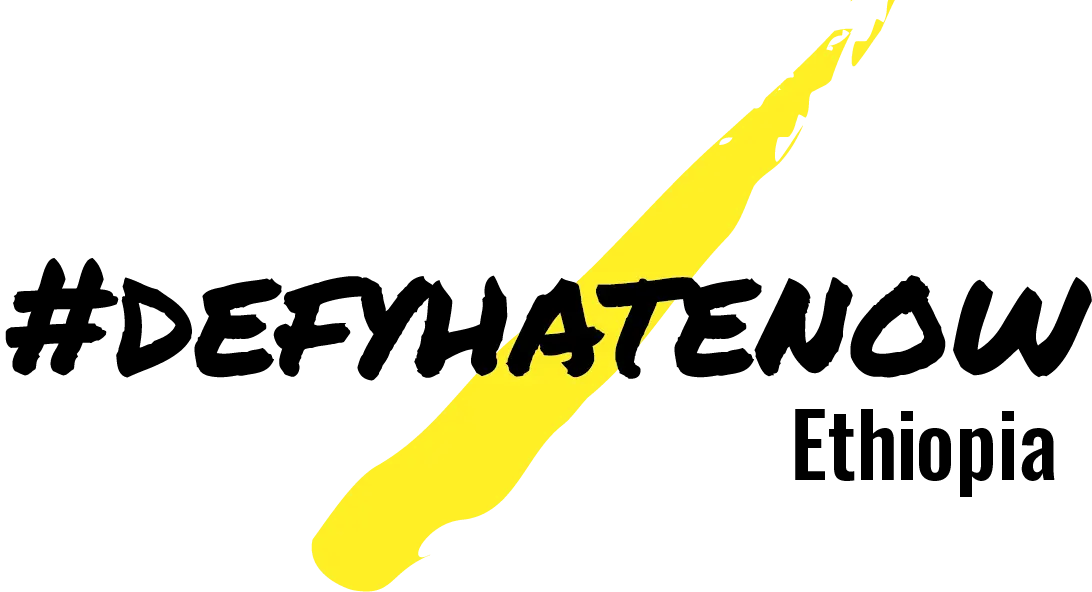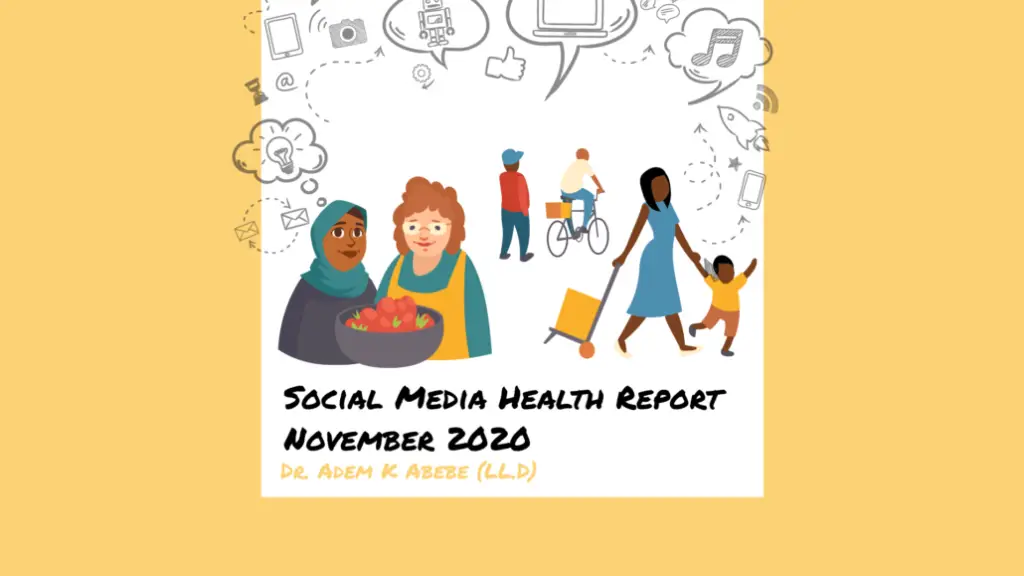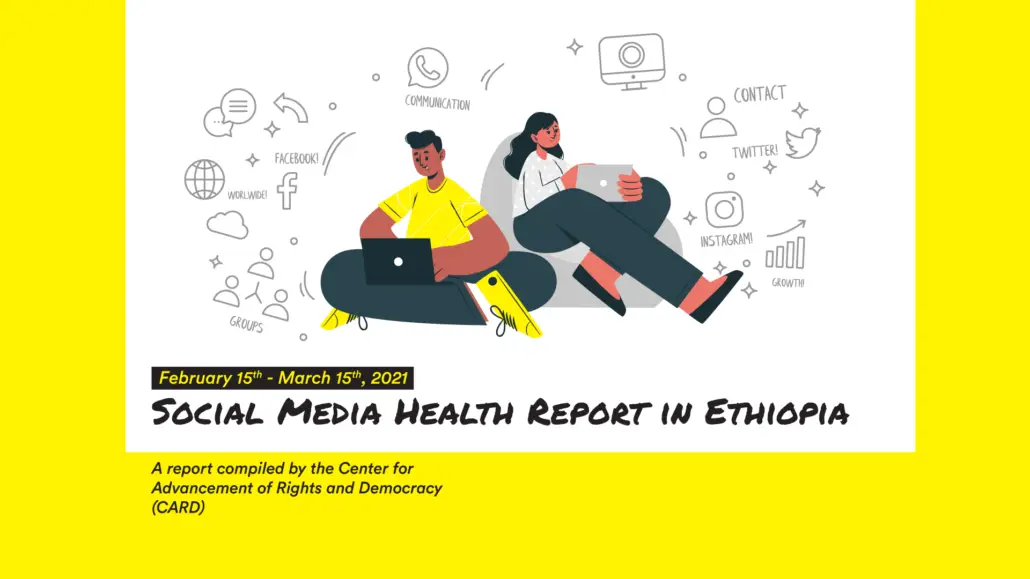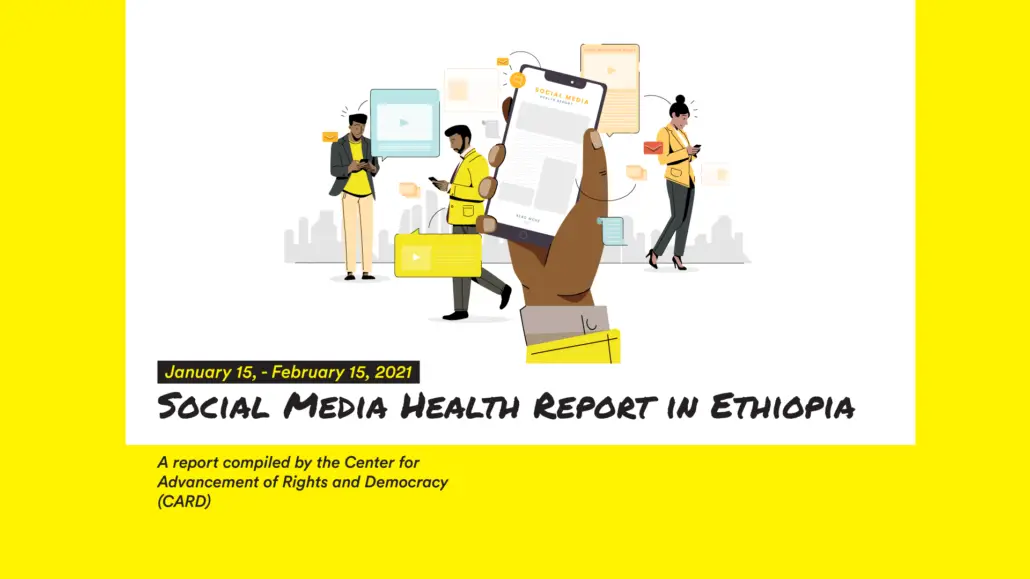Introduction
This social media health report construes the monitoring conducted in the working days between 1st to 15th of November 2020. The Health Report is aimed at mainly assessing the key issues/grievances on social media, the overall dynamics of hate speech in the country, and what they mean for the socio-political development of Ethiopia.
The monitoring of this month includes the overall assessment of social media activities through the platform of Crowd tangle and twitterbider. com. Key issues are determined based on the degree of interaction and the attention it received on social media.
Findings
Key Issues of the Month
In the first 15 days of the month of November, the following issues have been widely discussed:
■ The mass execution of civilians in West Wellega, Oromia. (November 2nd- 3rd)
In Guliso Woreda1, West Wellega zone of Oromia2 Region, 200 Amhara3 people were said to be called and forced to attend a meeting in a schoolyard and executed in mass. This happened hours after the Ethiopian military force left the place. The head of Oromia Regional Communication Bureau, Getachew Balcha said that militants bombed several local farmers after killing them. Out of the 200 people, the exact number of death was not exactly known as there were varying numbers reported. The victims were mostly children, women, and the elderly. According to Amhara Media Center, more than 60 people have been killed in the attack so far. At least 54 Amharas have been killed by militants, Amnesty International said in its statement. Whereas, Reuters news agency quoted Oromia regional officials saying the death toll was 32.
The Oromia massacre has sparked national outrage. The National Movement of Amhara (NAMA),4 said what happened was a genocide. The Amhara Regional State Prosperity Party5, for its part, has called on the federal government to consider the ongoing genocide against Amharas a threat to national security. President of the Oromia region, Shimeles Abdissa, said TPLF6 is training and arming the OLF Shene7 terrorist group operating in the Oromia region. Whereas, the Tigray8 People Liberation Front (TPLF) in turn accused the federal government of using the killings for political gain and called for an independent inquiry. Members of parliament also demanded a report on why the army left the area. The African Union (AU) and European Union(EU) have also raised their concerns about the situation in Ethiopia. “All parties must refrain from inflammatory speech,” African Union (AU) Chairperson Moussa Faki said.
■ A Twitter campaign demanding an independent investigation of the various killings in Ethiopia (November 2nd)
A Twitter campaign was organized demanding an independent investigation into the recent killings of civilians, regional officials, celebrities and military leaders in various parts of Ethiopia. It demands an investigation on who is behind the killings, where the government security forces were by the time the killings took place, why it failed to protect its citizens, and call for prosecution of those who failed to fulfill their responsibilities and take part in organizing and carrying out the assassinations. It additionally called for an international inquiry with the hashtag #IndependentInvestigationNow. Activists including Eyasped Tesfaye have been leading the campaign.
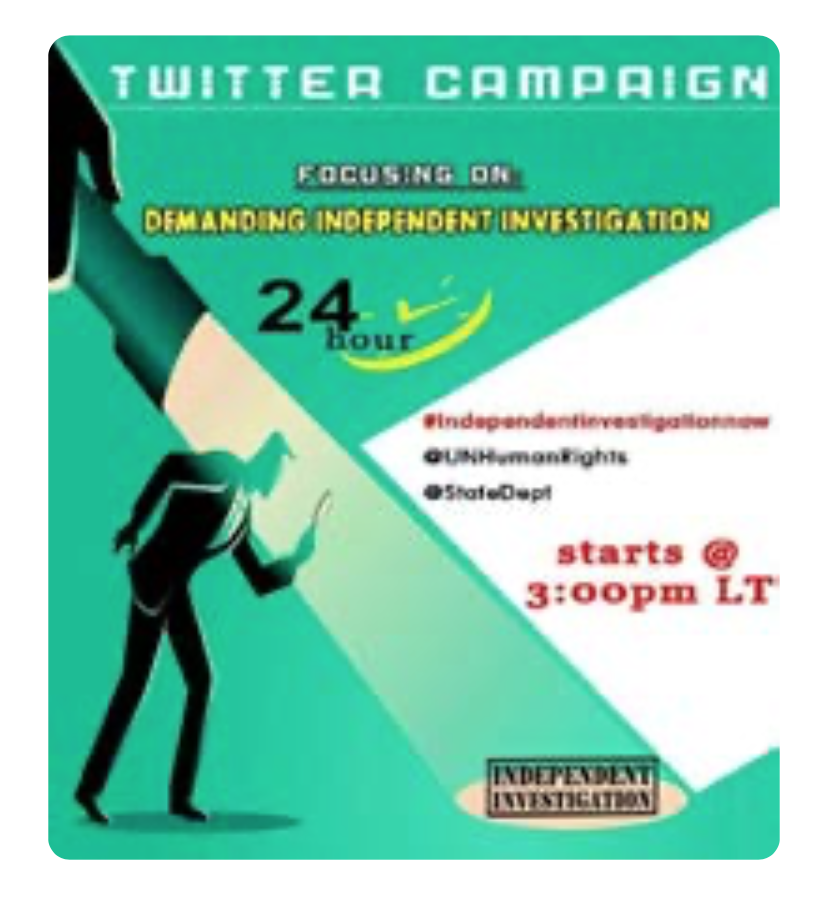
Image: Call for the campaign using the hashtag #IndependentInvestigationNow.

Chart 1: Mention trend of the campaign. 47,000 tweets have been made with the hashtag by 3158 unique authors
The above chart depicts the trend of mentions made using the hashtag #independentinvestigationnow from 2nd- 4th of November. We can see that there were no engagements with regards to that tweet or hashtag prior to the 2nd of November but it reached its peak on the 3rd of November.
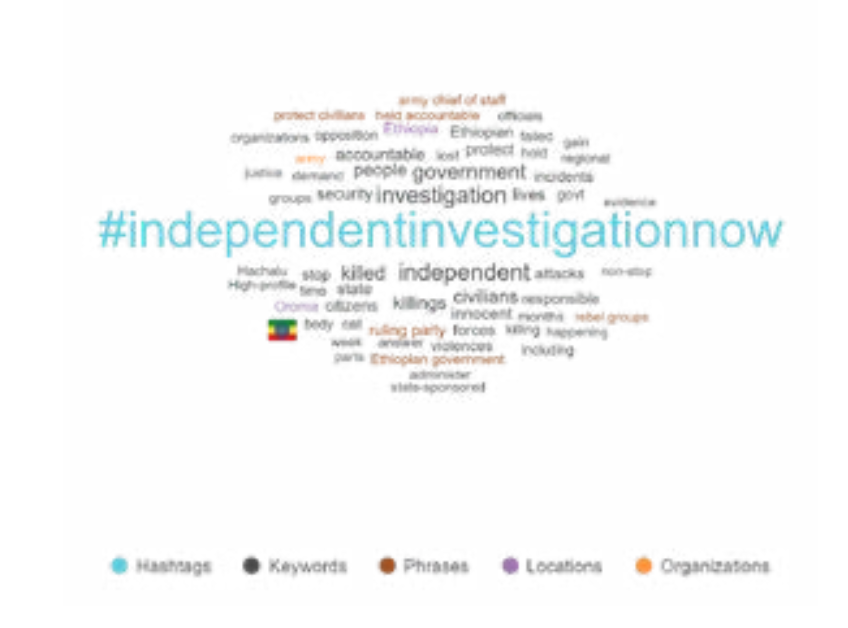
Chart 2: Topic wheel of the campaign
As the topic wheel chart above indicates, the hashtag #independentinvestigationnow has been tweeted with the keywords such as ‘killed’, ‘attacks’, ‘civilians’, ‘Innocent’, ‘responsible’, ‘independent’ and other keywords indicated above. The ‘ruling party’, ‘held accountable’, ‘protect civilians’ and ‘Ethiopian government’ were the phrases mostly tweeted on the campaign.
■ The military aggression between the Federal and Tigray governments (November 4th-15th)
The military aggression was first made public on the Facebook page of Ethiopian Prime Minister Abiy Ahmed. He said that the Tigray Regional State Armed Forces attacked the Northern Command Camp in the state and that the army, under the command of the command post, was “carrying out its mission to save the country”. He said it is a ‘law and order operation’ to bring the TPLF ‘junta’9 to justice and liberate the Tigrayan people.
Tigray Regional government, Dr. Debre Tsion Gebre-Michael, Chief Executive of the Tigray Regional State, however, denied they attacked the Northern command camp and said there are distant and close enemies who declared war on the people of Tigray hence “Tigray security forces are in a position to destroy them’’.
Shortly after the announcement by the prime minister, Internet and telephone service were cut off in Tigray State according to a report released by Netblock, an international group that monitors the country’s internet coverage.
N.B: The exact nature of the situation is not exactly known since both sides are giving contradictory information in most cases.
■ The extension of the opening date of universities and schools. (November 5th)
The Ministry of Science and Higher Education said in its statement that it has decided to delay the call for higher education graduates to return to school on October 23rd. The minister said the delay was due to security concerns in the country. The ministry urged students who have entered higher education institutions in the past days to stay on campus and wait for guidance and those who have not yet left their hometowns to stay where they are.
■ The declaration of a state of emergency in Tigray (November 4th)
The House of Peoples’ Representatives (HPR)10 approved the six-month state of emergency in Tigray region declared by the Council of Ministers11. The council said the SOE was needed because the security situation in Tigray violates the constitution and the constitutional order and endangers public peace. The security situation is beyond the control of regular law enforcement and violates the country’s sovereignty, the council added. Attorney General Gedion Timothewos said that the task force is authorized to disarm other militants, including the police, to declare over time and levy restrictions on transportation.
■ The arrest of Journalists (November 4th)
The editor-in-chief of Awlo Media, Bekalu Alamarew was arrested by police in Addis Ababa. The journalist was said to be abducted by Addis Ababa police officers wearing a uniform.
Ethiopian Human Rights Commission commissioner Daniel Bekele tweeted that the Commission was concerned about the arrest of four journalists. The journalists arrested are Haftu Gebre Egziabher, Tsegaye Hadush and Abraha Hagos of the Ethiopian Press Agency, and Udi Musa of the Oromo Media Network (OMN). He called for a look into the matter. Also, CPJ calls on Ethiopian authorities to release editor-in- chief of Awlo Media, Bekalu Alamarew.
■ A social media campaign with the hashtag #SayNoToWarEthiopia (November 4th- 15th)
A campaign that calls for an end to the “war between brothers’’ and call for reconciliation and dialogue to settle the dispute. The main influencers of this campaign were Dr. Senait Mebhratu, BBC Africa, Eleni Gebremehden and Henok Gabisa. A total of 32,000 tweets have been made using the hashtag, by 5910 unique authors until the 12th of November 2020.

Chart 3: volume of #SayNotoWarEthiopia tweet on Twitter.
The above chart depicts the total number of tweets made using the hashtag #SaynotoWarEthiopia from the 4th –12th of November. We can see that it reached its peak on the 10th of November.
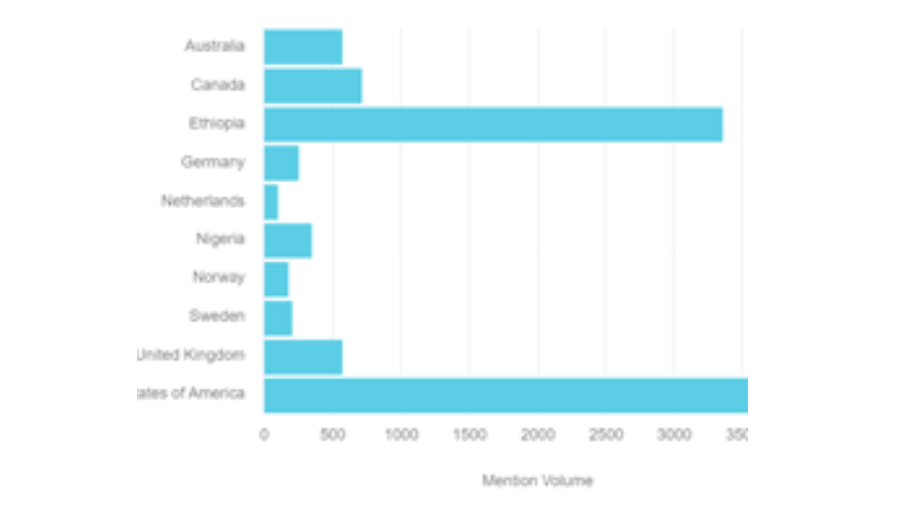
Chart 4: Volume of tweets by demography
Chart 4 shows the demography of participants in the campaign. Most of them were from the USA followed by participants from Ethiopia (3357 participants from Ethiopia and 3808 from USA.) This shows this is the only campaign we have seen so far where more tweets have been made from a foreign country. The country with the smallest volume of participation is the Netherlands.
■ The massacre of more than 500 people in Wolkait, Tigray. (November 10th -12th)
A heinous and inhumane killing of hundreds of civilians happened in Maikadra town of Wolkait Woreda in Tigray state. The National Movement of Amhara (NAMA), said in a statement that 523 Amharas were brutally massacred.
Deputy Prime Minister and Minister of Foreign Affairs Demeke Mekonnen announced on his Facebook page that TPLF militants and their allies have massacred many civilians in Wolkait, Tigray State. According to Amnesty International’s report, It ‘’has not yet been able to confirm who was responsible for the killings, but has spoken to witnesses who said forces loyal to the Tigray People’s Liberation Front (TPLF) were responsible for the mass killings, apparently after they suffered defeat from the federal EDF forces. Three people told Amnesty International that survivors of the massacre told them that they were attacked by members of Tigray Special Police Force and other TPLF members. The report quotes the statement of a witness saying, “Those wounded told me they were attacked with machetes, axes and knives. You can also tell from the wounds that those who died were attacked by sharp objects.”. The Tigray Regional government, however, condemned the report by Al and said they did not commit
such atrocities against the people of Amhara. They rather blamed the government of Abiy Ahmed and Isayas Afeworki, the Eritrean12 president, for directly or indirectly taking part in the massacre.
■ A social media campaign with the hashtag #TPLFIsTerroristGroup (November 10th- 12th)
This social media hashtag in addition with other hashtags TPLFisaKiller#TPLFmustgo #NoNegotiations#NoMercy was circulated both on Facebook and Twitter especially after the killings of the Maikadra town of Wolkait Woreda, Tigray state was reported on November 10th. People were angered with the news and claimed it was TPLF who did it.
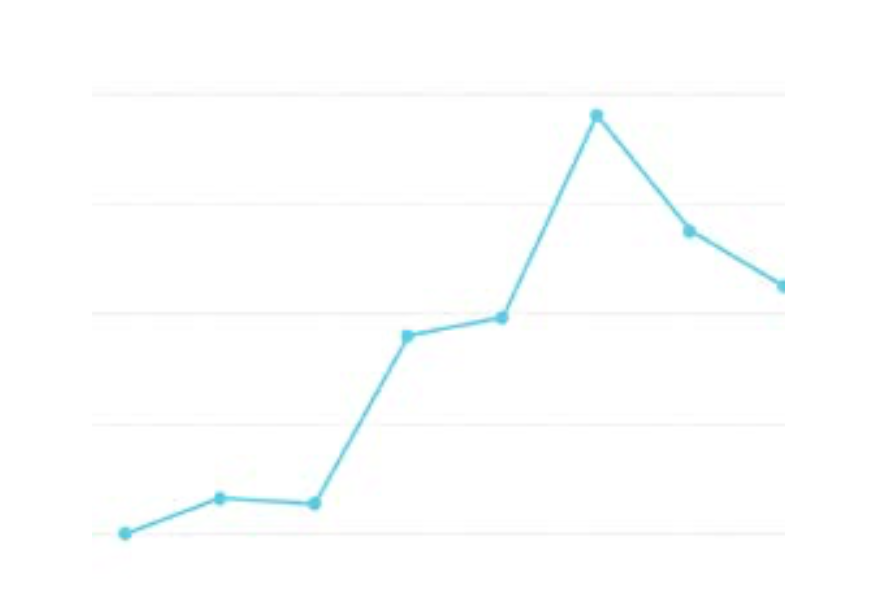
Chart 5: volume of #TPLFisterrioristgroup tweet on twitter.
Chart 5 depicts the total number of tweets made using the hashtag from the 6th – 12th of November. We can see that it reached its peak on the 10th of November where the assassination in Maikadra town was reported. A total of 5541 tweets were made using the hashtag by 2228 unique authors until the 12th of November 2020.
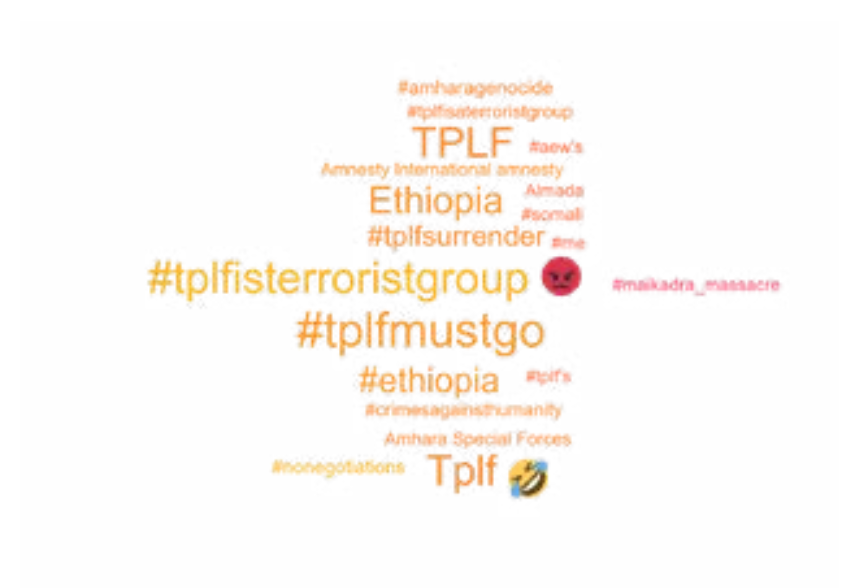
Chart 6: Hashtags used during the campaign.
The Chart above shows that many hashtags were used during the campaign with the leading hashtag and sub hashtags mentioned in the chart. Hashtags like #TPLF mustgo #TPLFsurrender and #maicadramassacre also trended. The issues raised range from grouping TPLF as a terrorist group to calling for International Human Rights Organizations for investigation.
■ The revocation of the right to immunity and issuance of an arrest warrant of TPLF Leaders (November 13-14)
The immunity of 38 individuals, including the President of Tigray Regional State and the Chairman of the TPLF, Dr. Debre Tsion Gebremichael has been revoked. Among those whose immunity has been revoked are senior TPLF leaders including Abay Tsehaye, Getachew Reda, Atsebha Aregawi and others. It’s alleged that the individuals whose immunity has been waived were suspected of various crimes. This includes gross treason, crimes against the constitution and the constitutional order and are also suspected of crimes against the country’s political and territorial integrity, harming the national security forces and participating in terrorist activities as well as being a major actor of terrorism.
The Federal police commissioner said in a statement that it had issued a warrant of arrest of TPLF members accused of treason.
■ The formation of an Interim administration for Tigray Regional state (November 13th)
The House of Federation unanimously approved a resolution calling on the federal government to intervene in the Tigray region and form an interim government (administration). According to the approved regulation, Dr. Mulu Nega has been appointed as the Chief Executive Officer of the administration established in the region. The chief executive becomes part of the temporary administration. They appoint officials from the various legal political parties operating in the region.
■ Rocket attacks in Bahirdar and Gondar (November 13-14th)
Amhara Regional State Communication Bureau reported that there was an explosion in Bahirdar and Gondar on the same day around midnight and was brought under control by security forces. Getachew Reda, spokesperson of the TPLF admitted that TPLF is responsible for the rocket attacks and the strikes targeted military bases in Bahir Dar and Gondar. He said it was in response to the airstrikes in Tigray.
■ The killings of civilians in Benshangul Gumuz13 (November 14)
Benishangul-Gumuz state government said civilians have been killed in an attack in Debate woreda. The regional government says innocent civilians have been killed in attacks by TPLF-backed militants. It also said that the security forces stopped public transport on the road from areas of Wombera,Bulen, Dibate, Chagni and carried out a vicious attack on innocent passengers. But, TPLF said nothing on this.
■ The release of two OLF leaders (November 14th)
Two OLF leaders, who had been detained for about four months, were each released on bail. Lemi Benya, head of the OLF Youth Wing, and Dawit Abdeta, head of organizational affairs in the Oromia Special Zone in Addis Ababa, were released.
■ The arrest of 14 members of Al-Shabaab and ISIS terrorists (November 14th)
The National Intelligence and Security Service (NISS) said in a statement to the media that 14 members of Al-Shabaab and ISIS terrorists who were planning to carry out terrorist attacks in Addis Ababa and other parts of the country have been arrested.
■ The explosion of a bomb that causes an injury to children (November 14)
Addis Ababa Police Commission said that, in Yeka Sub-City, Woreda 7, in an area known as ‘Captain Demissie’ Village, a bomb which was found while children were playing exploded and they were injured. A 13-year-old boy was seriously injured and four children were slightly injured
■ A rocket attack in Asmara, Eritrea (November 14-15th)
Following Getachew Reda’s warning to attack Eritrea, the city was hit by a rocket. And Dr. Debre Tsion G/Michael, admitting TPLF did it. TPLF told Reuters that it targeted Asmara airport. Whereas, the Eritrean government said they won’t make a counter- attack. No details were reported on this.
■ The fleeing of Ethiopians from the Conflict zone in Tigray to Sudan. (November 15th)
The United Nations High Commissioner for Refugees (UNHCR) reports that more than 20,000 Ethiopians have fled the conflict zone in Tigray to Sudan. According to the organization, 12,500 people fled to an area called ‘Hamidat’ and another 7,500 to ‘Al-Luqdi’. Half of the refugees are children and women, most of whom are Tigrigna language speakers; There are also a few injuries, said an official. The refugees were sheltered in temporary shelters in ‘Kesela’ and ‘Gaddafi’ states.

Social Media Analysis
The past 15 days have been marked by a series of agendas. The above- mentioned agendas mainly show that various incidents have taken place in the wake of the tension between the Federal and Tigray government.
The fact that the exact nature of the conflict in the region is unknown, has left the social media environment in a state of disarray, hate and division. This emanates from the fact that both the Federal and Tigray Regional governments are providing contradicting information on what is happening. Though the Prime Minister’s Office launched a new Facebook and Twitter page to provide timely and accurate information on the state of emergency and law enforcement operation established by the government in the Tigray region, the spread of mis/ disinformation is still increasing.
The ways in which the situation is described by different parties are concerning that they might lead to an ethnic clash. Among the ways of describing the situation are : A civil war, Law enforcement operation, genocide on the Tigrean people by the government of Abiy, A war between Amhara and Tigre, a conflict between those who seek unity in Ethiopia and those who are disintegrating Ethiopia and a war between the Ethiopian people and the “Junta”. The inability to know the exact nature of the situation and the release of opposing reports from both sides is greatly contributing to the spread of mis/disinformation and fake news and hatred among people.
When coming to the use of hate speech, hate content was being circulated widely especially following incidents taking place. For instance, The term ’Neftegna’14 showed a significant increase in two incidents. (See the chart below)
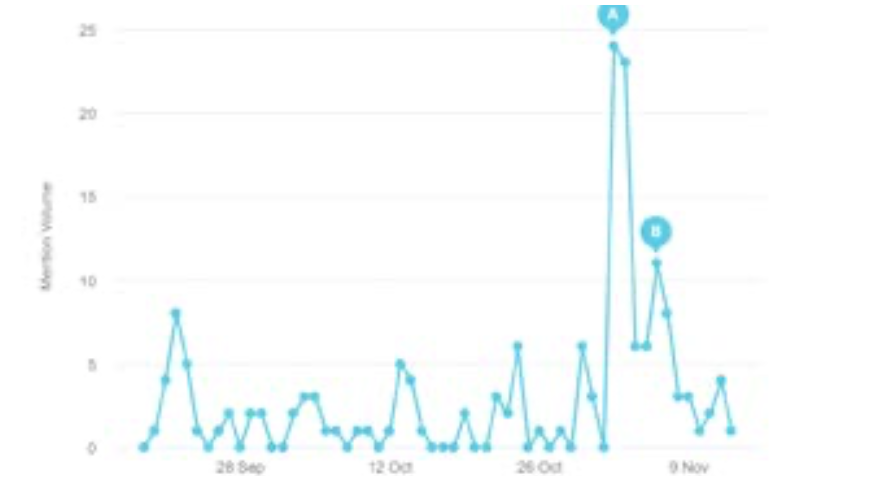
Chart 7: Mentions of the term ‘Neftegna’ (in Ge’ez terms) on Twitter
The above chart shows the mentions of the term ’Neftegna’ on Twitter. The word showed an increase on November 2 after the west Wollega killings and on November 4 after the Federal and Tigray governments military aggression started.
In the former case, most of the tweets have blamed the wide-spread use of the term for the attack. As it can be recalled, in West Wellega, 200 Amhara people were attacked hours after the Ethiopian military force left the place. This incident, which incited national outrage was followed by social media content that blamed the widespread use of the term ‘Neftegna’ for the attack, ‘’They call you ‘Neftegna’ while you were alive and ‘innocent’ when you get killed’’. This statement stated that the term ‘’Neftegna’’ is used to attack the people of Amhara, but are oppositely named as innocent when they finally get killed for it.
While in the latter, the term ‘Neftegna’ was used against the targets as the social media posts below clearly indicate. The involvement of the Amhara regional special forces in Tigray caused a perception that Amhara ethnic group is attacking the Tigray ethnic group, hence following that, hate speech against the Amhara was widely used.
image 2: Twitter post. Translation: ‘’Neftegna is the enemy of all nation and nationalities of Ethiopia!!! Other nationalities, do not join in the genocide of Tigrigna-speaking innocent people and save yourself from the guilt of history’’


image 3: This is a Facebook post which calls for brutality against Amhara people who participate on the ongoing military aggression between the federal government and the TPLF group. It claims each of their leg and hand to be cut as a symbol and fed to the beasts.
And there were also contents which have an anti-Tigrean sentiment.

Image 3: This was found in a comment section on a Facebook post about the ongoing war in Tigray region, the comment stated that the people of Tigray are the eternal enemy of Ethiopia. Threats of violence were also part of the social media interaction.
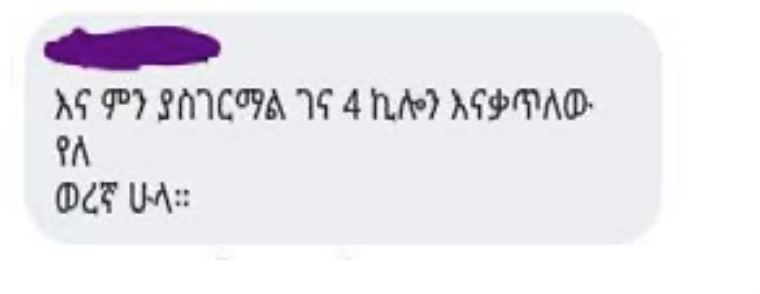
Image 4: The image below is a Facebook comment in response to a post on the frustration of people about bombings and unanticipated attacks on different parts of the country. It stated that bombing of the national palace at 4 kilo is yet to come.
The wide circulation of fake images about the ongoing tension is also another concern. Images from previous incidents in Ethiopia and other countries were fakely used. The image below can illustrate this.
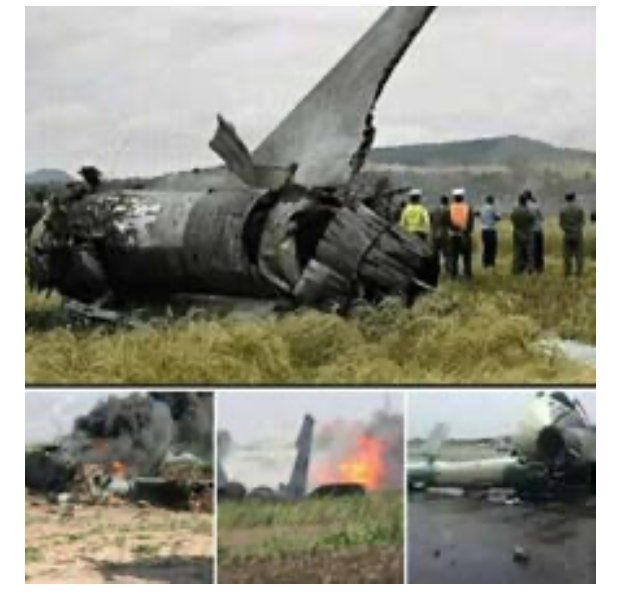
Image 5: The image shows the fighter jets crashed in Ethiopia in 2013 and 2019 and in Sudan in 2020. However, it was shared on social media as if the Tigray Special Forces attacked the military jets of the Defense Force.
Moreover, It’s worrisome that some terms might become newly emerging hate terms unless proper care is taken. The words being used by various government officials in their speeches in the media might open the door to new hate terms to target a certain ethnic/ religious group. Here, it’s important to recall how the term ‘Neftegna’ used by Shimeles Abdisa in his speech years ago, has been and is a viral hate term which still is being used to attack the people of Amhara.
Similarly, We can mention the recent terms ‘Junta’ and ‘Yeshererit Dir’15, used by the Prime Minister and the former president of the Amhara Regional State, Temesgen Tiruneh respectively. “The people of Amhara shall destroy its strategic enemy or the spider, the spider’s web should not exist.” Temesgen Tiruneh said.
Since social media users use new words in a way that suits their online content, it’s concerning these terms might also be emerging hate terms unless caution is taken.
Apart from social media, the News media is also a concern. They are spreading conspiracies. The image to the left can illustrate this. It says ‘Demonstrations were held to intensify the declared war on Tigray.’ The phrase ‘’…the declared war on Tigray.’ is misinforming and dangerously hate inciting among people.
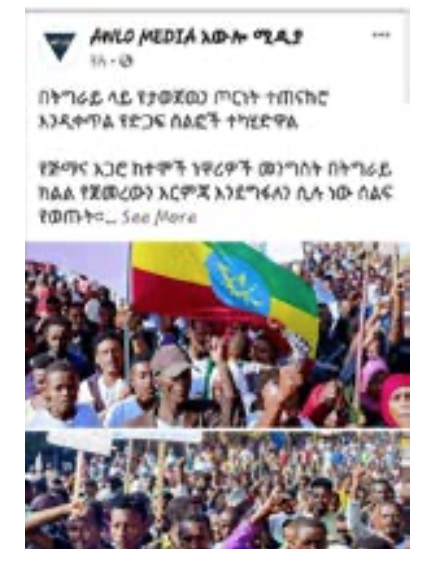
Conclusion
This report has attempted to analyse online hate speech and fake news in Ethiopia by using CARD’s social media mapping reports, discourse and content analysis. The 15 days assessment report concluded that the current social media acts are becoming a serious concern. Not only on posts but comment sections are also the main sources of hate speech. Additionally, accounts are being used to spread fake news, incite violence and to spread hateful content related to the current tension. The existing condition especially shows how the low level of transparency of the government bodies in giving accurate and timely information is opening the door for fake news. Not only that, new and viral words used by government officials in their speeches in the media might be paving the way for newly emerging hate terms.
Moreover, the assessment observed that there is an overlap in what people are talking about and sharing on social media. The usage of different facts might be a contributing reason for the low level of shared attention. There are varying realities shared and therefore people are exposed to different opinions. Social media users, rather than being open and having a civil conversation, prefer using insults and inflammatory terms.
Therefore, the report asserts that the overall social media engagement is unhealthy and hateful contents as well as calls for violence are being produced and circulating at an alarming rate. Moreover, the News media are also spreading conspiracies and using conflict insensitive methods of reporting. This is the time where the problems need to be well-addressed before they lead to an unforeseen ethnic clash.
 Loading…
Loading…
References
- The term woreda (District in English) refers to the smallest unit of an administrative division.
- Oromo is a member of an ethnic tribe located mostly at Central Ethiopia whose dominant language is oromiffa (Kushtic)
- Amhara is member of an ethnic tribe located at the north and north west of Ethiopia whose dominant language is Amharic (Semetic)
- National movement of Amhara (NAMA), is an opposition political party, established to ensure the interests of Amhara and defend them from ethnic- based attacks in different parts of Ethiopia.
- Amhara prosperity party is the Amhara region wing representing the present federal government of Prosperity party
- TPLF, popularly known as Wayane, is a political party in Ethiopia which is said to be a struggle for the Freedom of Tigray. It led a coalition of movements named the Ethiopian People’s Revolutionary Democratic Front (EPRDF) from 1989 to 2018. It ruled Ethiopia until its refusal to merge into the Prosperity Party in 2019.
- Oromo Liberation Front Shine (OLF Shine) is an organization which is said to be “part of OLF”,an organization said to be founded to bestow freedom to the Oromo people.
- Tigre is member of an ethnic tribe located at the north of Ethiopia whose dominant language is Tigrigna (Semetic)
- Junta is a term mostly used for an army (part of an army/government) who has been identified as a “bandit” or treacherous. PM Abiy Ahmed in this case referred to TPLF as Junta.
- The House of Peoples’ Representatives is the lower chamber of the Ethiopian Federal Parliamentary Assembly,having 547 members who are elected for five-year terms in single-seat constituencies.
- The Council of Ministers is the cabinet of the Government of Ethiopia. It is the country’s executive body.
- Ertirea is a country in Eastren Africa, formerly a part of Ethiopia that has undergone cessation from Ethiopia during the period of EPRDF
- Benshangul Gumuz is one of the regional states of Ethiopia and is located in the north-western part of Ethiopia, They speak the Gumuz language (Nilo- Saharan family)
- Neftegna (“riflemen” in English) is a term formerly used to define an ordinary solider of Amharas’ descent. However, now is one of the hate words used to define any person from any ‘Amharas’ lineage and in some cases the Orthodox Religion in a provocative way.
- Yeshererit dir’(English-Spider Web) is an unravelable web wrapped around oneself and cannot be destructed unless one kills the spider which wove it. Former President of the Amhara Region, Mr. Temesgen Tiruneh, referred TPLF as the spider and the chain amongst them as the web.
